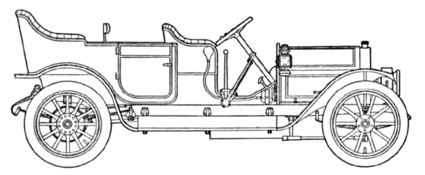Great Southern Automobile Company
The Great Southern Automobile Company was the first automobile manufacturer in the central South. It was incorporated in Birmingham on October 27, 1909 and manufactured automobiles, automobile parts, and buses from a former cotton mill at 3rd Avenue and 8th Street.
The company's founding officers were Eugene Enslen, president; Ike Adler, vice-president; John Kyser, secretary and treasurer; and Eugene Enslen, Jr general manager.
In early 1910, Great Southern announced a "Model 50" touring car with a wheel base of 124 inches, and a 5.25x6 inch bore and stroke engine capable of 60 brake horsepower. The company increased its capital stock from $100,000 to $500,000 and invested in improvements to its manufacturing plant and repair center. It employed as many as 200 people that year.
In 1912, Great Southern opened sales rooms in the Empire Building, then the tallest building in Birmingham. The manager was W. O. Fields.
In 1913, Great Southern manufactured two models: the "Great Southern 30", available in a two-seater roadster and five-seater touring bodies for $1,400 and the "Great Southern 51", available as a six-seater touring car for $2,100. The cars were built with the driver's seat on the right side.
In 1914, it dropped the roadster and concentrated on the larger touring car, again called the "Model 50". The seven-passenger touring car included a 4-cylinder water-cooled engine and 3-speed cone transmission. The wheelbase was 128 inches with 36" diameter tires. The updated model moved the control levers to the center console. The base price was dropped to $1,750, with the option of any lighting package and cranking apparatus on the market at extra cost.
By 1915, Great Southern was manufacturing a chassis and body for a "one-man, pay-enter" motor bus that was 22 feet long, 8'-9" high, and 7'-6" inches wide with a 197-inch wheelbase. It was rated at 2.25 tons capacity, and could carry 25 passengers at a maximum speed of 16 miles per hour. The body frame was of metal and ash with ash doors and windows and cane seats.
The company went bankrupt in 1917.
References
- "Great Southern Incorporates" (November 18, 1909) The Automobile. Vol. 21, p. 886
- 1912-03-12 "In The Retail World" (March 12, 1912) The Motor World. Vol. 30, No. 11, p. 1033
- 1914-01-01 "Great Southern" (January 1, 1914) Motor Age. Vol. 25, No. 1, p. 63
- "One-man, Pay-enter Motor Bus Design" (April 1915) The Hub. Vol. 57, No. 1, p. 34
